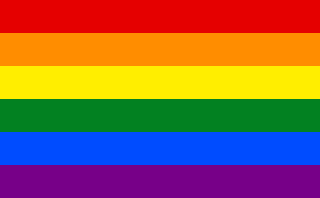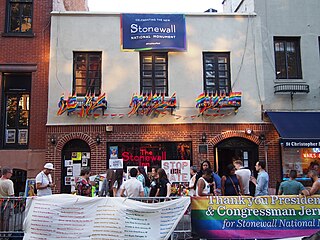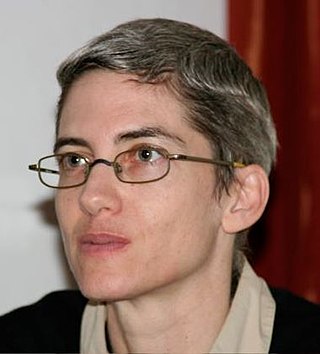
Queer is an umbrella term for people who are not heterosexual or are not cisgender. Originally meaning 'strange' or 'peculiar', queer came to be used pejoratively against LGBT people in the late 19th century. From the late 1980s, queer activists began to reclaim the word as a neutral or positive self-description.

LGBTQ is an initialism for lesbian, gay, bisexual, transgender and queer or questioning. It is an umbrella term, originating in the United States, broadly referring to all sexualities, romantic orientations, and gender identities which are not heterosexual, heteroromantic, cisgender, or endosex.

Sexuality and gender identity-based cultures are subcultures and communities composed of people who have shared experiences, backgrounds, or interests due to common sexual or gender identities. Among the first to argue that members of sexual minorities can also constitute cultural minorities were Adolf Brand, Magnus Hirschfeld, and Leontine Sagan in Germany. These pioneers were later followed by the Mattachine Society and the Daughters of Bilitis in the United States.

The LGBTQ community is a loosely defined grouping of lesbian, gay, bisexual, transgender, and queer or questioning individuals united by a common culture and social movements. These communities generally celebrate pride, diversity, individuality, and sexuality. LGBTQ activists and sociologists see LGBTQ community-building as a counterweight to heterosexism, homophobia, biphobia, transphobia, sexualism, and conformist pressures that exist in the larger society. The term pride or sometimes gay pride expresses the LGBTQ community's identity and collective strength; pride parades provide both a prime example of the use and a demonstration of the general meaning of the term. The LGBTQ community is diverse in political affiliation. Not all people who are lesbian, gay, bisexual, or transgender consider themselves part of the LGBTQ community.
Queer studies, sexual diversity studies, or LGBTQ studies is the study of topics relating to sexual orientation and gender identity usually focusing on lesbian, gay, bisexual, transgender, gender dysphoric, asexual, aromantic, queer, questioning, and intersex people and cultures.
Heteronormativity is the concept that heterosexuality is the preferred or normal sexual orientation. It assumes the gender binary and that sexual and marital relations are most fitting between people of opposite sex.

Non-heterosexual is a word for a sexual orientation or sexual identity that is not heterosexual. The term helps define the "concept of what is the norm and how a particular group is different from that norm". Non-heterosexual is used in feminist and gender studies fields as well as general academic literature to help differentiate between sexual identities chosen, prescribed and simply assumed, with varying understanding of implications of those sexual identities. The term is similar to queer, though less politically charged and more clinical; queer generally refers to being non-normative and non-heterosexual. Some view the term as being contentious and pejorative as it "labels people against the perceived norm of heterosexuality, thus reinforcing heteronormativity". Still, others say non-heterosexual is the only term useful to maintaining coherence in research and suggest it "highlights a shortcoming in our language around sexual identity"; for instance, its use can enable bisexual erasure.

LGBTQ culture is a culture shared by lesbian, gay, bisexual, transgender, and queer individuals. It is sometimes referred to as queer culture, LGBT culture, and LGBTQIA culture, while the term gay culture may be used to mean either "LGBT culture" or homosexual culture specifically.

Lesbian, gay, bisexual, transgender, and queer (LGBTQ) rights in Cuba have significantly varied throughout modern history. Cuba is now considered generally progressive, with vast improvements in the 21st century for such rights. Following the 2022 Cuban Family Code referendum, there is legal recognition of the right to marriage, unions between people of the same sex, same-sex adoption and non-commercial surrogacy as part of one of the most progressive Family Codes in Latin America, as well as amongst communist countries. Until the 1990s, the LGBT community was marginalized on the basis of heteronormativity, traditional gender roles, politics and strict criteria for moralism. It was not until the 21st century that the attitudes and acceptance towards LGBT people changed to be more tolerant.

The lesbian, gay, bisexual, transgender and queer (LGBTQ) people in the Philippines are generally accepted in Filipino society, and it has been ranked among the most gay-friendly countries in Asia. It has the second highest social acceptance rate in the Asia-Pacific next to Australia, according to a Pew Research Center survey in 2013. Despite this, some discrimination still persist and LGBT people have limited LGBT-specific rights, leading some activists to characterize LGBT culture in the Philippines as "tolerated, but not accepted." Homosexuals in the Philippines are known as "bakla", though there are other terms to describe them. According to the 2002 Young Adult Fertility and Sexuality Survey, 11 percent of sexually active Filipinos between the ages of 15 and 24 have had sex with someone of the same sex. According to Filipino poet and critic Lilia Quindoza Santiago, Filipino culture may have a more flexible concept of gender. Kasarian is defined in less binary terms than the English word; kasarian means "kind, species, or genus".
This article focuses on Japanese definitions of gender and sexuality, Japanese reactions to queer life, the clash between traditional and contemporary ideas, and the cultural restraints of being queer in Japan. The Western term “queer,” an umbrella term for lesbian, gay, bisexual, and transgender (LGBT) represents a change in thought pertaining to gender and sexuality in contemporary Japan.
Queer heterosexuality is heterosexual practice or identity that is also controversially called queer. "Queer heterosexuality" is argued to consist of heterosexual, cisgender, and allosexual persons who show nontraditional gender expressions, or who adopt gender roles that differ from the hegemonic masculinity and femininity of their particular culture.

LGBTQ sex education is a sex education program within a school, university, or community center that addresses the sexual health needs of LGBTQ people.
Despite the history of colonisation and the resulting process of Westernisation since 1842, Hong Kong still embodies many aspects of Chinese traditional values towards sexuality. It is traditionally believed that heterosexuality is the nature, coherent, and privileged sexuality. Popular media marginalises and discriminates against LGBT members of Hong Kong in an attempt to maintain "traditional lifestyles".

The following outline offers an overview and guide to LGBTQ topics:
Today, LGBTQ individuals are victimized and very little has been done to resolve this issue in Guatemala, and Latin America for that matter. Guatemalans who identify as queer are consistently ostracized for struggling to conform to a heteronormative society that Guatemala has instituted. Sexual minorities are denied essential services such as education and healthcare, and the Guatemalan State has done very little to provide aid to LGBTQ individuals, insinuating that Guatemala is an anti-LGBT country. The State is portrayed as not providing enough aid to protect the well-being of the LGBT community from discriminatory rhetoric and violence.
Queer erasure refers to the tendency to intentionally or unintentionally remove LGBTQ groups or people from record, or downplay their significance, which includes lesbian, gay, bisexual, transgender, and queer people. This erasure can be found in a number of written and oral texts, including popular and scholarly texts.
Les is a derogatory local Vietnamese term of identification for more globally common labels like lesbian, queer woman, or female homosexual. It is derived mainly from scholarship by Vietnamese-American ethnographer Natalie Newton, who is, at present, the only Western scholar to have centred Vietnam's les as her subject of investigation. Her articles have been frequently cited as reference or point of entry to issues concerning Vietnamese queer communities.

Amal Ziv is an Israeli academic and researcher. Their research areas are pornography and sexual representations, queer culture, queer activism, and queer kinship. Because of their activism and research, Ziv is considered a prominent member of the LGBTQ and feminist communities in Israel.
Homonormativity is the adoption of heteronormative ideals and constructs onto LGBT culture and identity. It is predicated on the assumption that the norms and values of heterosexuality should be replicated and performed among homosexual people. Those who assert this theory claim homonormativity selectively privileges cisgender homosexuality as worthy of social acceptance.








